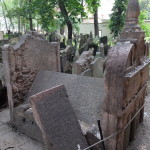
Molded by hand out of dust and clay, like the Adam of Genesis, and given life by invoking God, the legendary golem carried a dual power. Intended as a protector of the Jewish community from its oppressors, the golem could turn uncontrollably into a destroyer as well.
As you can learn from popular tours and guidebooks, 16th-century teacher Rabbi Judah Loew ben Bezalel is reputed to be the creator of the golem, despite the likelihood that the golem story was an early 19th century tale akin to Mary Shelley’s Frankenstein.
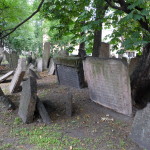
Rabbi Loew came to Prague from Poland, the largest of the Jewish communities, and founded an influential line of Talmudic teaching still important today. His ark-like tombstone in Prague celebrates the man within the atmospheric cemetery that contains thousands more ancient gravestones now pushed askew by time. A short street away, his synagogue – the Old New – still stands from that time with his wooden seat #1 reserved right next to the ark of the stored Torah.
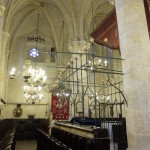
Like the golem, conditions for Jewish communities in Europe could foster opportunity when the political climate – in the hands of religious leaders or monarchs – was favorable, but could be perilous at other times.
In 16th and 17th century Czechoslovakia, Jews found economic viability in trades like tanning and tailoring, or just working the farms they could own – as well as professional trades like doctors, merchants and financiers. Traditions of Jewish mysticism found fertile ground and respect in the local princes’ zeal the esoteric knowledge of alchemy.
Little towns flourished more or less into the mid-19th century when the Hapsburgs loosened restrictions on living in the big cities, so villagers could flee from the harsh economics and constraints of village life. The populations slowly declined as many went to Prague and other large cities, or emigrated to the more welcoming new world across the Atlantic. The population of the Jewish Quarters shrank somewhat, some synagogues were decommissioned, but the village communities hung on into the mid-20th century. Then the golem failed to stop the Nazis’ mass deportations and killing in the concentration camps.
Since then, particularly in the last few decades, some of these small towns have honored the nearly lost heritage of their former neighbors by restoring the Jewish quarters. And they offer diverse exhibitions – interactive histories, photos, displays of religious articles, etc. – to instruct visitors.
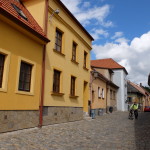
Trebic in the Czech Republic’s Moravian area, for example, offers one of the best and most extensive looks at what a small town’s Jewish quarter looked like around the mid-19th century. It was so well preserved and then actively restored that it earned UNESCO World Heritage standing. The old dwellings survived mainly because the structures were inhabited by subsequent generations of locals – and little altered on the outside. Other buildings like the old Town Hall served various useful purposes. A synagogue at one end of the Quarter was turned into a church. Another, the now restored Rear, or New, had become a warehouse for wood, potatoes or munitions at different times.
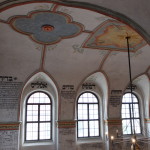
Perhaps at night the shadows speak more eloquently of the old community. During the day, however, the long streets filled with late model cars and largely empty of people make it difficult to envision the past. Plaques on several buildings do tell of their earlier residents and uses. Yet the sparsely decorated and freshly painted houses that uninterruptedly line the streets hardly seem old.
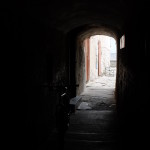
It helps to tour that restored Rear Synagogue, with its surprising frescoes and its display of the town as it used to look, and, literally fused to it, a domestic household with a ground floor shop, furnished from the 1920s.
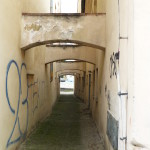
On the streets, small touches also invoke the past: a few dark ground-floor passageways connecting residences, small courtyards, narrow lanes with odd arches that seem to hold the buildings apart, and crooked brick staircases climbing the steep hillsides. In these you can imagine some of the life and stones of the late 19th and early 20th century.
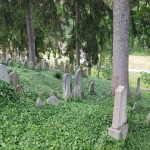
Up the steps, Trebic – whose Jewish population at its peak reached just a few thousand – has also preserved a hillside cemetery filled with the tightly packed graves of over 10,000 people buried there across a span of 350 years. The site is grassy and pleasant, at the end of a suburban street surrounded by two city parks, one of which looms over the old Jewish Quarter and the rest of the town. Most of the gravestones carry simple decorations and much text, recalling names, professions and virtues. Meter-long stone houses, like Rabbi Loew’s in Prague, memorialize notable leaders and teachers. Many of the gravestones seem to hold tenuously onto the steeply slanting ground. Others are broken or askew, worn smooth over time. .
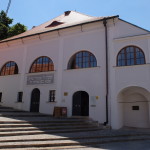
In Michalov, a small town at the center of Moravian wine-making, a half-dozen now protected homes on one renamed street still recall some of the look of its Jewish Quarter. One old synagogue with its splendid domed interior still stands, now unused except as a memorial for those no longer here. It offers an interactive history of the Jews in Moravia and the town’s quarter, and displays artifacts of the life they lived here. Other towns like this can be found across Eastern Europe.
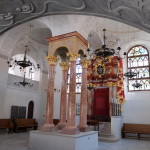
Back in Rabbi Loew’s Prague – much of the stones that housed the Jewish community have, somewhat like a broken clay golem, disappeared into dust. World War 2 destroyed many large cities in Eastern Europe, along with their Jewish Quarters. But even before that, urban renewal knocked so much down.
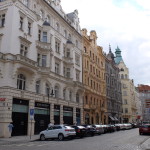
Around the turn of the 19th century, Prague’s leaders replaced centuries-old homes with art nouveau buildings, creating sumptuous streets like Parizska, the Fifth Avenue of modern Prague. More recently in Bratislava, the communist leadership ran a highway through the Jewish Quarter imitating Mussolini’s road building through the Roman Forum.
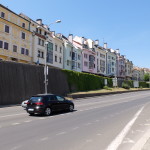
What’s left in Prague mostly huddles near the old cemetery where Rabbi Loew is buried. There are a few scattered synagogues, and a few other interesting structures like the baroque Town Hall and Renaissance meeting hall.
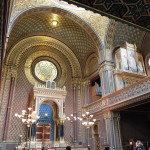
The grandest synagogue, a bit farther off, is the so-called Spanish Synagogue. The walls of its large, exquisitely ornate prayer hall dazzle with geometric Moorish designs. It presents popular concerts for visitors to town.
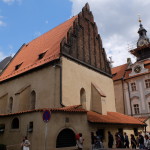
A block from the cemetery is Rabbi Loew’s Old-New Synagogue, Prague’s oldest, dating back to the 17th century, a virtual cavern entered from below ground and still used for prayers. Next to it is the Quarter’s baroque Town Hall with its double clock: the one with Hebrew numerals runs counter-clockwise.
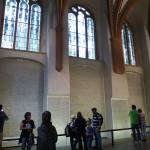
The most mournful building, however, is the Pinchas Synagogue, adjacent to the cemetery. From room to room, its walls have been inscribed with a seemingly endless list of those who died during the war from harsh conditions or attacks in the ghettos or at the concentration camps. Upstairs, it also displays drawings by children from within the camp to which most Prague Jews were sent, nearby Terezin, or Theresienstadt.
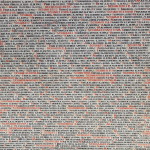
The cemetery itself is more tightly jammed with gravestones than Trebic. Yet, for us, the shadows of the more recent dead, those remembered on the inscribed walls and in their innocent drawings, are more tangible. We have relatives who, unlike theirs, live today because of Schindler.
And in the cemetery, below his ark-like memorial, still lie the remains of Rabbi Loew, whose golem failed to protect the community, except for memories and those few clay or stone buildings we can see today.
(Also, for more pictures from Czech Republic, CLICK HERE to view the slideshow at the end of the Czech Republic itinerary page.)


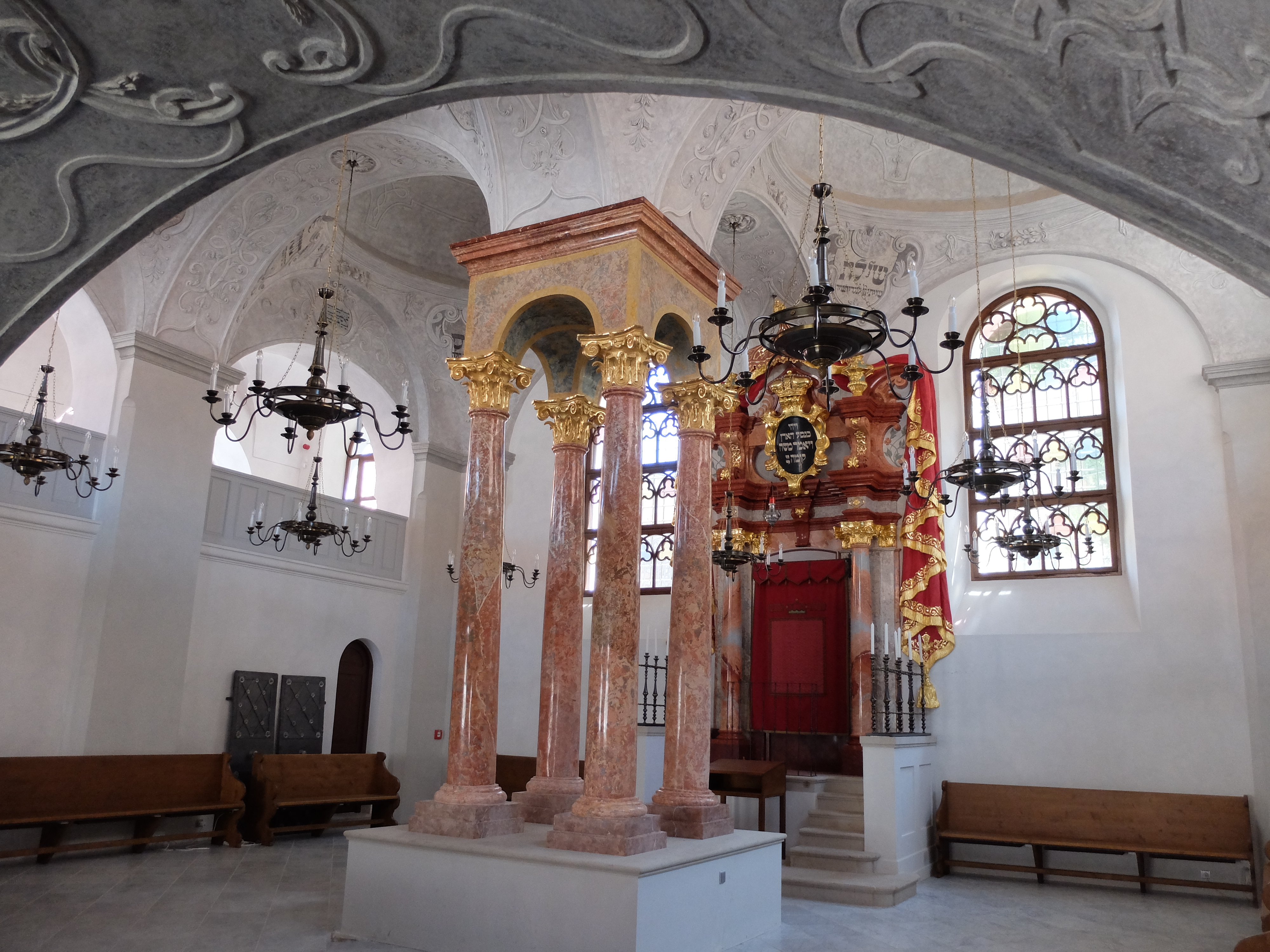
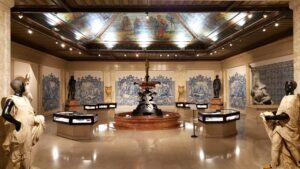
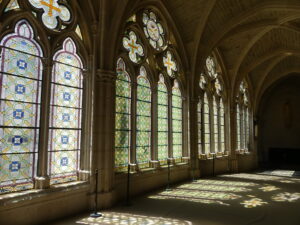
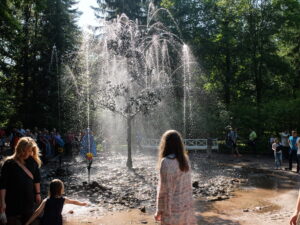
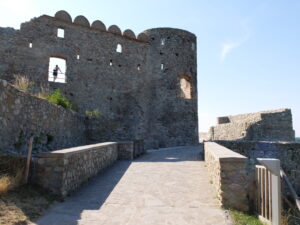
I’m so glad you visited the Jewish quarters. We saw all the Prague synagogues and the old cemetery. Stunning.